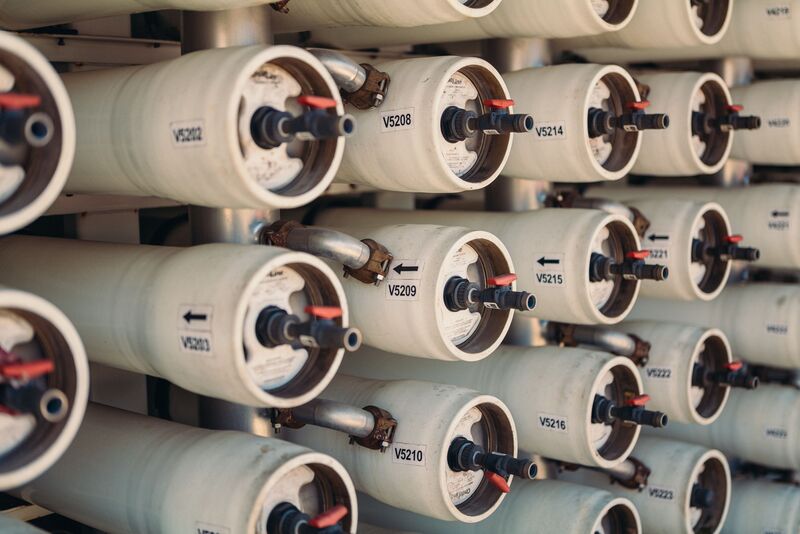Reverse osmosis (RO) is a proven and widely used method for purifying water. By passing water through a semi-permeable membrane, the process effectively removes a wide range of impurities—including dissolved salts, bacteria, organics and pyrogens. This makes RO a safe, efficient, and cost-effective solution for industries that require consistently high-purity water.
How Does Reverse Osmosis Work?
R
Reverse osmosis relies on pressure to push water through a semi-permeable membrane. While water molecules are able to pass through, most contaminants are left behind.
Here’s a breakdown of the typical process:- Pre-treatment: The incoming water is first filtered to remove larger particles such as sediment, rust, and chlorine, which could damage the membrane.
- Membrane separation: The heart of the system, this stage filters out microorganisms, dissolved solids, and other fine impurities.
- Post-filtration: After the membrane, water may go through additional filters to remove any remaining trace contaminants.
- Storage and polishing: Purified water is stored in a holding tank, and in some systems, it is further refined with a final filtration stage for extra purity.

Why Choose Reverse Osmosis for Water Treatment?
RO systems offer a host of operational and economic advantages:
-
Broad treatment capabilities for various water types and applications
-
Energy-efficient performance, running at ambient temperatures
-
Enhanced safety due to reduced reliance on chemicals
-
Compact designs that fit into space-constrained environments
-
Continuous operation without downtime for regeneration
-
Straightforward installation, often skid-mounted for convenience
-
Flexible integration with existing treatment infrastructure
-
Simplified maintenance via user-friendly controls and automated cleaning systems
Where Is Reverse Osmosis Used?
Reverse osmosis systems are utilised across a wide range of industries and markets. These include:
Pharmaceuticals: RO systems are crucial for producing high-purity water used in drug manufacturing, water for injection and more. Our Orion is a skid-mounted, multi-technology purified water system that is fully validated and compliant with FDA, cGMP, and GAMP requirements. It is an ideal choice for pharmaceutical companies in need of reliable and high-quality purified water solutions.
Healthcare: RO is widely employed across a range of healthcare processes. We have meticulously developed a diverse range of RO systems, each intricately designed to cater to the differing processes within the healthcare market. These RO systems include the Modula for renal dialysis, the Osiris for sterile services and the Thermapure decontamination. Read more.
Food & Beverage: RO technology plays a vital role in producing purified water for beverage manufacturing, food processing, and ingredient preparation. By removing contaminants and impurities from the water, RO technology guarantees that the final products meet the stringent requirements of governing industry bodies and maintain consistent purity and taste. Our NURION™ is a compliant reverse osmosis (RO) system that produces high-quality ingredient water for the food and beverage industry.
Municipal: RO is a key process in desalination plants, where it removes salt and other impurities from seawater to produce freshwater for drinking and irrigation purposes. Our Sirion™ Seawater has been specifically designed to treat seawater by rejecting over 99% of the salt contained within the feed water.
Industrial: Many industries require high-quality water for their specific processes, such as electronics manufacturing or power generation. RO systems provide the necessary purification to meet these requirements. Our TERION range removes over 99.9% of dissolved inorganics, producing the highest specification of process water.
RO systems also aid in the recovery of wastewater by purifying it for reuse in various industrial and agricultural applications. Models in our Sirion™ range can also achieve wastewater recovery.
The Value of Reverse Osmosis
Reverse osmosis remains one of the most effective methods of water purification across a wide array of industries. With the right system in place, organisations can benefit from greater process reliability, regulatory compliance and sustainability gains.
At Veolia Water Technologies Ireland, we provide tailored RO solutions that align with your specific needs - whether it’s for pharmaceutical production, food-grade processes or industrial reuse.
Have a question or ready to explore options for your site?
Contact our team today to speak with a reverse osmosis specialist.


